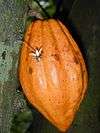Chocolate bar

A chocolate bar is a chocolate confection in bar form, which distinguishes it from bulk chocolate produced for commercial use or individually portioned chocolates such as pastilles,[1] bon-bons, and truffles. In most of the English-speaking world, chocolate bar also refers to a typically snack-sized bar coated with or substantially consisting of chocolate but containing other ingredients.
A chocolate bar made exclusively from chocolate contains some or all of the following components: cocoa solids, cocoa butter, sugar, and milk. The relative presence or absence of these define the subclasses of chocolate bar made of dark chocolate, milk chocolate, and white chocolate. In addition to these main ingredients a chocolate bar may contain flavorings such as vanilla and emulsifiers such as soy lecithin to alter its consistency.
Chocolate bars containing other ingredients feature a wide variety of layerings or mixtures that include nuts, fruit, caramel, nougat, and fondant. A popular example is a Snickers bar, which consists of a nougat mixed with caramel and peanuts.
Chocolate bars are often loosely called candy bars in North American English, a term that encompasses similar treats produced without chocolate, such as the Zagnut and Bit-o-Honey bars. A wide selection of similar chocolate treats are produced with added sources of protein and vitamins. These include forms of energy bar and granola bar and are sold as snacks and nutritional supplements.
History
Up to and including the 19th century, confectionery of all sorts was typically sold in small pieces to be bagged and bought by weight. The introduction of chocolate as something that could be eaten as is, rather than used to make beverages or desserts, resulted in the earliest bar forms, or tablets. At some point, chocolates came to mean any chocolate-covered sweets, whether nuts, creams (fondant), caramel candies, or others. The chocolate bar evolved from all of these in the late-19th century as a way of packaging and selling candy more conveniently for both buyer and seller; however, the buyer had to pay for the packaging. It was considerably cheaper to buy candy loose, or in bulk.
In 1847, Joseph Fry found a way to mix the ingredients of cocoa powder, sugar and cocoa to manufacture a paste that could then be molded into a chocolate bar proper for consumption.[2] Subsequently, his chocolate factory, known as the Fry's chocolate factory and located in Bristol, England, began mass-producing chocolate bars and they became very popular.[3] The firm began producing the Fry's Chocolate Cream bar in 1866.[2] Over 220 products were introduced in the following decades, including production of the first chocolate Easter egg in UK in 1873 and the Fry's Turkish Delight (or Fry's Turkish bar) in 1914.[2] In 1896, the firm became a registered private company and was run by the Fry family, with Joseph Storrs Fry II, grandson of the first Joseph Storrs Fry, as Chairman.
Although chocolate bars had their beginnings in the 19th century, their sales grew most rapidly in the early-20th century.[4] In North America, Ganong Bros., Ltd. of St. Stephen, New Brunswick, developed and began selling their version of the modern chocolate bar in Canada by 1910. The Hershey Chocolate Company took the lead in the U.S.[4]
The world's largest "chocolate bar" was produced as a stunt by Thorntons plc (UK) on 7 October 2011. It weighed 5,792.50 kg (12,770.3 lb) and measured 4m by 4m by 0.35m.[5]
Among the oldest preserved chocolate bars are two pieces of white and dark chocolate made between 1764 and 1795 for the king of Poland, Stanislaus Augustus Poniatowski, as a gift for his courtiers.[6] Each bar, possibly made by the royal confectioner in Warsaw, bears the King's monogram, SAR, and is on display in his summer residence, Palace on the Water, in Warsaw.[6]
See also
- Energy bar
- Granola bar
- List of chocolate bar brands
- List of chocolate-covered foods
- United States military chocolate
References
- ↑ Dark Chocolate Pastilles. Haigh's Chocolates.
- 1 2 3 "The History of Candy Bars". Candy History. Retrieved August 20, 2015.
- ↑ Candy Bar History
- 1 2 Fahey, Miller, David M., John S. (2013). 20, 2015 Alcohol and Drugs in North America: A Historical Encyclopedia Check
|url=value (help). ABC-CLIO. p. 164. - ↑ Guinness World Records "Largest chocolate bar" http://www.guinnessworldrecords.com/world-records/1/largest-chocolate-bar-Accessed 22/10/2013
- 1 2 "Dwa cukierki - czekoladki" [Two sweets - chocolates] (in Polish). The Royal Łazienki Museum. Archived from the original on 2016-11-11. Retrieved 10 November 2016.
Further reading
- Almond, Steve (2004) Candyfreak, Algonquin Books of Chapel Hill, ISBN 1-56512-421-9
- Broekel, Ray (1982) The Great American Candy Bar Book, Houghton Mifflin Co., ISBN 0-395-32502-1
- Richardson, Tim (2002) Sweets: A History of Candy, Bloomsbury, ISBN 1-58234-307-1
External links
| Wikimedia Commons has media related to Chocolate bars. |
